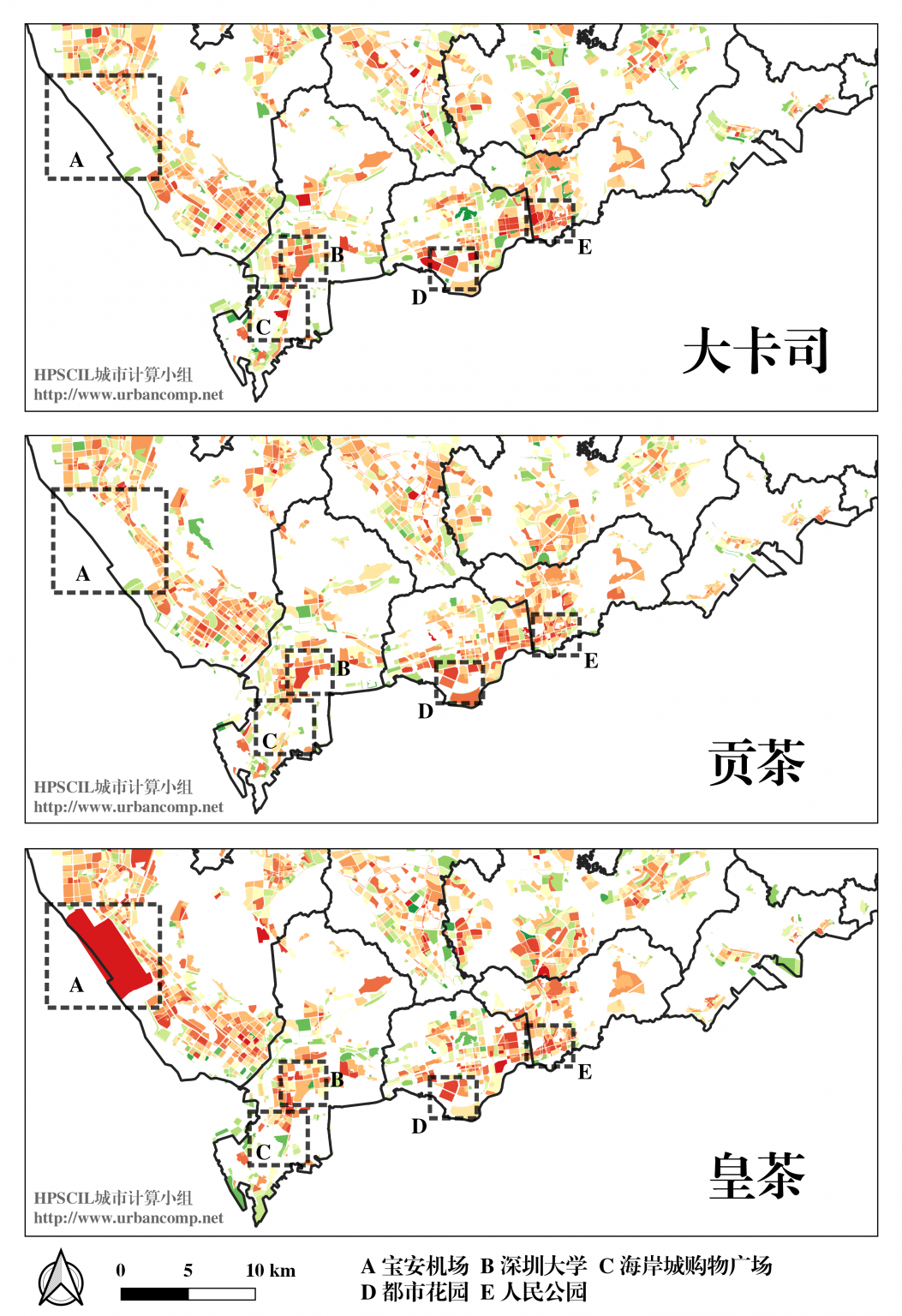什么是商业连锁店铺的"冷启动"问题呢?
What is a commercial chain store "cold start" site selection problem?
举个例子,如果在一个城市里,我需要开一家连锁店铺(比如"星巴克")。但是,这家城市没有任何一家星巴克,我们也没有任何星巴克在这座城市的营业经验。因此,这三个问题是作为营业者需要考虑的:
For example, if I need to open a chain store in a new city (e.g. "Starbucks Coffee"), but there is no Starbucks in this city, and we do not have any experience with operating the Starbucks in this city. Before we set up a new Starbucks, we need to consider the following questions.
- 我该如何进行商铺的选址,能收获最高的营业利润?
- 我能否考虑用其他城市的星巴克开业经验,对这一座新的城市进行选址?
- 这座城市其他竞争品牌店铺(比如瑞幸和Costa咖啡等)的营业经验,是否也可对我选择合适地址开业提供参考?但我们也需要防止这些品牌的营业地点会和我形成竞争关系。
- How do I choose a location for my store that will yield the highest operating profit?
- Can I consider using the experience of Starbucks openings in other cities for this new city location?
- Will the experience of other competing stores in the city (e.g. Ruixing and Costa Coffee) also help me choose the right location for my business? But we also need to prevent the location of these brands from competing with mine.
这就是连锁商铺的跨城市"冷启动"选址问题。
This is the problem of cross-city "cold-start" location selection for retail chains.
有研究指出,选址会决定一个店铺在同一个城市的营收差异达到90%。我们知道,而且店铺在一个区域的适宜性会受到不同城市的营业环境、社会经济、竞争品牌分布、居民的行为活动特征和居民爱好(比如饮食习惯:广东人不吃辣,江西人不吃甜,江浙人口味清淡)等等多方面影响。
Studies have shown that location can determine up to 90% of the variance in revenue for a store in the same city. We know that the suitability of a store in a region will be affected by the different cities' business environment, socio-economic, competitive brands, the behavior of the residents, and the residents' hobbies (such as eating habits: Guangdong do not eat spicily, Jiangxi do not eat sweet, Jiangsu and Zhejiang have a mild taste) and so on.
因此,我们可以采用大数据挖掘城市的社会经济、营业环境等变量,并将已有的类似店铺(竞争品牌)营业经验抽象为数学模型。我们提出了一种全新的人工智能和知识迁移的方法,可以有效的解决城市内和城市间商业店铺的多种选址问题,甚至包括"冷启动"问题。
We can use big data to mine the urban variables, including socio-economic and business environment, and abstract the business experience of similar stores (competitive brands) already existing in the city into a mathematical model. We propose a brand new approach to artificial intelligence and knowledge migration that can effectively solve a variety of intra- and inter-city commercial store location problems, including the "cold start" problem.
我们即将推出数据支撑的相关计算和咨询服务。
We will soon launch our data-supported computational and consulting services.
这是一个示例。
Here is an example.
我们有广州市三家奶茶店(大卡司、贡茶、皇茶)的营收信息和广州市的多源空间数据,那这时我假设深圳市分别没有其中一家店,但有另外两家店的营收数据。
We have revenue information for three milk tea shops in Guangzhou (Da Kashi, Gong Cha and Royal Tea) and multi-source spatial data for Guangzhou, so I assume that there is no revenue for one of the shops in Shenzhen, but there is revenue for the other two shops.
举个例子,我假设深圳市没有皇茶这家店,那么我通过广州的营业环境、社会经济、居民行为活动和三家奶茶店铺的销售数据;结合深圳的营业环境、社会经济、居民行为活动特点,和大卡司、贡茶的销售数据,采用GIS、人工智能和知识迁移相结合的方法,推理得到深圳市皇茶在每个小区的选址后销售理论值是多少(或选址适宜性如何)。
For example, I assume that there is no Royal Tea store in Shenzhen, then I use the multi-source spatial variables, which can be used to indicate the business environment, socio-economic, residents behavioral activities, in Guangzhou and the sales data of the three milk tea stores; combine the multi-source spatial variables in Shenzhen, and the sales data of Da Kashi and Gong Cha, and use a combination of GIS, artificial intelligence and knowledge migration to infer the theoretical value of the sales of Royal Tea in Shenzhen after choosing the location in each community (or the suitability of the location).
此时,我得到深圳市中心城区的选址结果如图1所示。和真实销售数据对比后,每家店的销售额预估和实际对比的精度可以到到90%以上。
Figure 1 shows the site selection results in downtown Shenzhen City. After comparison with the actual sales data, the accuracy of each store can be up to more than 90%.

图1 基于我们的模型得到的深圳市中心城区大卡司、贡茶和皇茶冷启动选址结果
Figure 1 Cold start site selection results for Da Kashi, Gong Cha and Royal Tea in downtown Shenzhen based on our model. From top to down: Da Kashi, Gong Cha and Royal Tea. (A) Baoan airport, (B) Shenzhen University, (C) Coastal City Shopping Plaza, (D) Urban Garden and (E) People's Park.
从图1可以明显的发现,我们准确的挖掘出不同品牌的小区级的适宜性(销售量),并有效的挖掘了其他城市和其他店铺的营业特征。从图1可以明显发现,由于区域经济水平、竞品分布和人群消费特征的不同,在不同的小区、不同的品牌奶茶店有着不同选址适宜性和消费人群倾向。
From Figure 1, it is obvious that we have explored the community-level suitability (sales volume) of different brands and explored the business characteristics of other cities and other stores accurately.
Due to different levels of regional economic development, the spatial distribution of competitive brand shops distribution and crowd consumption habits, different brands of milk tea shops in different communities have different site suitability and consumer trends.
城市居民区域(都市花园)适合所有奶茶店的选址。最适合大学区域(深圳大学)的是相对平民化的贡茶和大卡司。而在消费较高的商业中心(海岸城)和机场最适合消费较高的皇茶开展连锁,在充分考虑成本的情况下,也可以获得最大的营业利润。而在人民公园附近,根据公园附近不同的消费人群属性分布,可以发现三家连锁奶茶店都对应着不同的选址适宜区域。
The urban residential area (Urban Garden) is suitable for all milk tea shop locations. The university area (Shenzhen University) is best suited for the relatively inexpensive Gung Cha and Da Kashi.
The commercial center (Coastal City) and the airport are the most suitable for the higher consumption of Royal Tea to start a chain. Even if the cost of opening a store is high, Royal Tea can make the most profit due to the high traffic and high level of customer spending.
In the vicinity of People's Park, according to the distribution of different consumer attributes near the park, it can be found that the three chain milk tea shops correspond to different suitable locations.
敬请期待!
Coming soon!
参考论文 (Reference):
Q.E.D.









